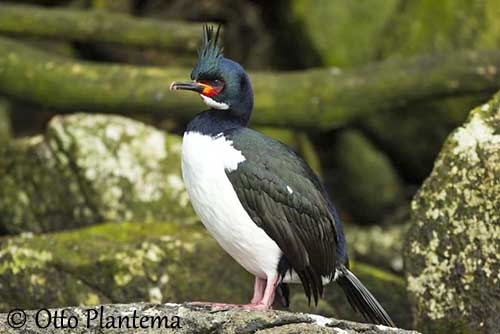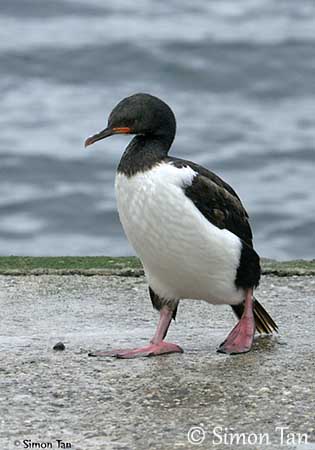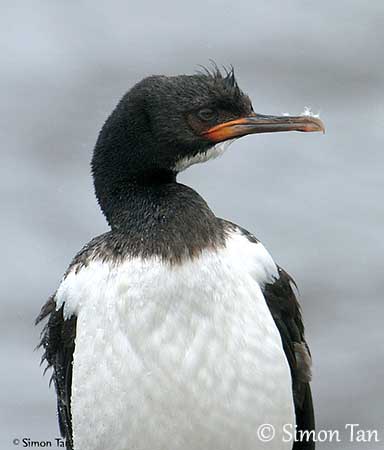
Fr: Cormoran de Campbell
Ang: Campbell Shag – Campbell Island Shag
All: Campbellscharbe
Esp: Cormorán de la Campbell
Ita: Marangone dell'Isola Campbell
Nd Campbellaalscholver:
Sd: Campbellskarv
Photographers:
Otto Plantema
Trips around the world
Simon Tan
PBase Bird galleries
Text by Nicole Bouglouan
Sources:
HANDBOOK OF THE BIRDS OF THE WORLD vol 1 by Josep del Hoyo-Andrew Elliot-Jordi Sargatal - Lynx Edicions - ISBN: 8487334105
BirdLife International (BirdLife International)
New Zealand bird status between 2008 and 2012
Te Ara – The Encyclopedia of New Zealand
Museum of New Zealand – TE PAPA TONGAREWA
Page family Phalacrocoracidae
Summary cards
Campbell (Island) Shag
Leucocarbo campbelli
Suliformes Order – Phalacrocoracidae Family
INTRODUCTION:
The Campbell Shag is included in the pink-footed shag species endemic to New Zealand. This one is endemic to Campbell Island and adjacent coastal waters. It is the only Phalacrocoracidae present on this island.
Campbell Island is a predator-free area with the eradication of rats in 2001, whereas the feral cats disappeared in the late 1980s. However, a natural predator, the Brown Skua (Stercorarius antarcticus lonnbergi) may sometimes take eggs and chicks, but it does not threaten the populations.
DESCRIPTION OF THE BIRD:
Biometrics:
Length: 63 cm
Wingspan: 105 cm
Weight: 1600-2000 g
The adult in breeding plumage is black-and-white. Head, neck, throat and upperparts show metallic blue-green sheen in sunlight. The tail is black. The white wing patches can be conspicuous, reduced or absent.
Chin and underparts are pure white. Thighs and underwing are black.
On the head, there is a black, recurved shiny crest on the forecrown. Facial skin and throat pouch vary from dark purple to red-orange. There is a yellow line above the gape, and a yellow or red spot below.
This species lacks the facial caruncles and the blue eyering of the northernmost pink-footed shag species.
The long bill is dark greyish-brown with pinkish-orange hooked tip. The eyes are dark brown. Legs and webbed feet are pale pink.

Both sexes are similar. In non-breeding plumage, they lack the crest and the black plumage becomes browner.
The juvenile has dull brown plumage. The facial skin is duller, mostly purple-brown. The throat pouch is dull orange-yellow.
RANGE:
The Campbell Shag occurs on Campbell Island, S of New Zealand.
HABITAT:
The Campbell Shag is often seen in sheltered harbours and inlets, especially during winter, on E and S coasts. It forages in open sea too, usually within 10 kilometres from the main island.
It breeds and roosts on sea cliffs, stacks or islets, and occasionally among tussocks.
CALLS AND SONGS:
The Campbell Shag male produces characteristic barking calls during the courtship displays. It is usually silent away from the colony.
BEHAVIOUR IN THE WILD:
The Campbell Shag feeds on small fish and marine invertebrates. They often feed in large flocks of 30 to 100 birds. A flock of up to 2000 birds has been recorded in Perseverance Harbour. They form a line and beat the water with their wings, before to dive for preys.
Like numerous cormorants, they dive from the surface and use their powerful webbed feet to propel themselves underwater where they can swim a long distance while pursuing a prey.

During the breeding season, the Campbell Shag becomes more vocal. The male performs elaborate displays. It walks with horizontal body, breast down and rump up. It swings the head back and forth while producing some gargling sounds. It also performs tail-raising, bill-gaping and crest-lowering.
Mates often greet one another by waving their wide-open bills back and forth. They are monogamous.
The Campbell Shag is sedentary on Campbell Island and adjacent coastal waters.
The flight is powerful with regular, continuous wingbeats and occasional glides. The head is held below the body-level during the flight.
REPRODUCTION OF THIS SPECIES:
The breeding season occurs between November and February.
The Campbell Shag often breeds in colonies of up to 150 nests, established in large sea caves, cliff ledges or beneath overhanging rocks. Some pairs may nest solitary. The colonies can be mixed with Laridae species.
The nest is a flattened bowl made with tussock grass, twigs and debris.
The female lays 2-3 pale blue eggs. From an observation of a colony in 2010, the adults were incubating in February, and there were large chicks in April. At hatching, the chicks are naked and have black skin. Later, after one week, a dark brown down is growing.
The breeding behaviour of this species is poorly known, but usually, the incubation lasts about 23-25 days, shared by both adults. The eggs are incubated on the webs of their feet. The chicks are brooded and fed by both parents. The young fledge between 50 and 80 days after hatching.
PROTECTION / THREATS / STATUS:
The Campbell Shag has probably stable populations, thanks to the eradication of introduced mammalian predators.
The Brown Skua is a natural predator of eggs and chicks, but it does not affect the numbers. Population trends are unknown but the species is naturally uncommon.
Due to the restricted breeding range making this species threatened by human impacts, the Campbell Shag is classified as Vulnerable.
